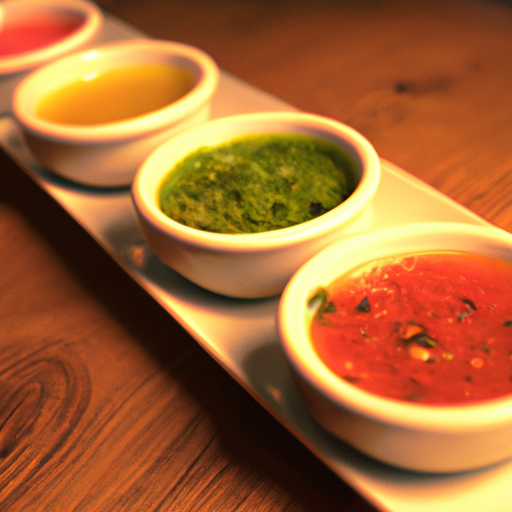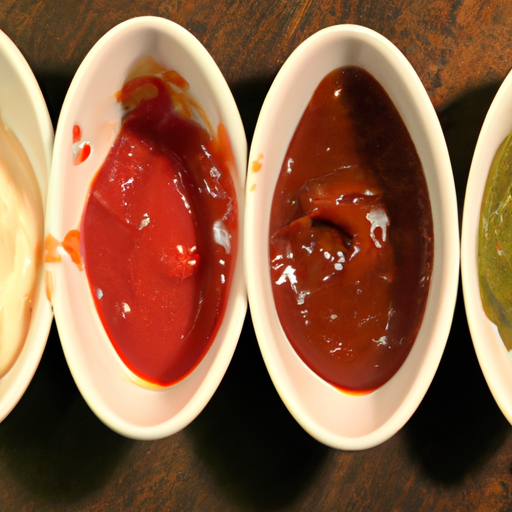
The History and Origins of the Five Mother Sauces
The history and origins of the five mother sauces are deeply rooted in classical cuisine. These sauces, which form the foundation of countless dishes, have been perfected over centuries and continue to be essential in the culinary world today. Let’s take a journey back in time to explore the fascinating origins of these sauces.
The concept of mother sauces can be traced back to the 19th century, when French chef Auguste Escoffier classified and codified the basic sauces used in French cuisine. He identified five sauces that formed the basis for countless variations and combinations. These sauces were known as the mother sauces, as they served as the starting point for creating a wide range of other sauces.
The first of the mother sauces is béchamel. This creamy and velvety sauce is made by combining milk with a roux, which is a mixture of equal parts flour and butter. Béchamel sauce originated in France and was named after Louis XIV’s steward, Louis de Béchamel. It quickly became a staple in French cuisine and is commonly used in dishes such as macaroni and cheese and lasagna.
Next up is velouté, a sauce made from a light stock, such as chicken or fish, thickened with a roux. The word velouté means “velvety” in French, which perfectly describes the smooth and silky texture of this sauce. Velouté sauce is often used as a base for seafood dishes and is a key component in classics like shrimp bisque and chicken pot pie.
Espagnole, the third mother sauce, has its roots in Spanish cuisine. This rich and flavorful sauce is made by combining a dark brown roux with beef or veal stock, along with various herbs and vegetables. Espagnole sauce is the base for many classic French dishes, including beef bourguignon and demi-glace.
The fourth mother sauce is tomato sauce, or as the French call it, sauce tomate. This vibrant and tangy sauce is made by simmering tomatoes with onions, garlic, and various herbs and spices. Tomato sauce is incredibly versatile and is used in a wide range of dishes, from pasta and pizza to meatballs and stews.
Lastly, we have hollandaise sauce, a luxurious and buttery emulsion made from egg yolks, butter, and lemon juice. Hollandaise sauce originated in the Netherlands but gained popularity in France, where it became a staple in classic dishes like eggs Benedict and asparagus with hollandaise. This sauce requires careful attention and technique to achieve the perfect consistency, making it a true test of a chef’s skill.
These five mother sauces form the building blocks of classical cuisine and have been passed down through generations of chefs. While they may seem simple on their own, they provide a solid foundation for countless variations and combinations, allowing chefs to unleash their creativity in the kitchen.
In conclusion, the history and origins of the five mother sauces are deeply intertwined with the development of classical cuisine. From béchamel to hollandaise, each sauce has its own unique story and plays a crucial role in the culinary world. So, the next time you enjoy a delicious dish, take a moment to appreciate the centuries of culinary tradition that have gone into creating the perfect sauce.
How to Master the Techniques of Making the Five Mother Sauces

The Five Mother Sauces of Classical Cuisine are the foundation of countless delicious dishes. These sauces, also known as the “grand sauces,” are the starting point for many classic French recipes. Mastering the techniques of making these sauces is essential for any aspiring chef or home cook looking to elevate their culinary skills.
The first mother sauce is Béchamel, a creamy and velvety sauce made from a roux of butter and flour, combined with milk. To make a perfect Béchamel, start by melting butter in a saucepan over medium heat. Once melted, add an equal amount of flour and whisk until smooth. Gradually pour in warm milk, whisking constantly to prevent lumps from forming. Continue cooking and whisking until the sauce thickens to a smooth consistency. Season with salt, pepper, and a pinch of nutmeg for added flavor.
Next up is Velouté, a light and delicate sauce made from a roux of butter and flour, combined with a light stock such as chicken, fish, or veal. To make Velouté, melt butter in a saucepan and whisk in flour until smooth. Gradually add the stock, whisking constantly until the sauce thickens. Simmer the sauce for a few minutes to allow the flavors to meld together. Season with salt and pepper to taste.
Espagnole, the third mother sauce, is a rich and flavorful brown sauce. To make Espagnole, start by browning a mixture of diced onions, carrots, and celery in butter or oil. Add flour to create a roux and cook until it turns a deep brown color. Slowly add beef or veal stock, whisking constantly to prevent lumps. Simmer the sauce for at least an hour to develop its rich flavor. Strain the sauce to remove any solids and season with salt and pepper.
The fourth mother sauce is Hollandaise, a luscious and buttery sauce made from egg yolks, butter, and lemon juice. To make Hollandaise, whisk egg yolks and lemon juice together in a heatproof bowl. Place the bowl over a pot of simmering water, making sure the bottom of the bowl does not touch the water. Gradually whisk in melted butter, a little at a time, until the sauce thickens and emulsifies. Season with salt and a pinch of cayenne pepper for a subtle kick.
Lastly, we have Tomato Sauce, a versatile and tangy sauce made from tomatoes, onions, garlic, and herbs. To make Tomato Sauce, sauté diced onions and minced garlic in olive oil until softened. Add crushed tomatoes and simmer the sauce for about 30 minutes to allow the flavors to meld together. Season with salt, pepper, and herbs such as basil, oregano, or thyme to enhance the taste.
Mastering the techniques of making these five mother sauces opens up a world of culinary possibilities. Once you have mastered the basic recipes, you can experiment with different variations and add your own twist to create unique and delicious sauces. These sauces can be used as a base for countless dishes, from pasta and lasagna to roasted meats and seafood.
So, grab your whisk and saucepan, and start practicing these techniques. With a little patience and practice, you’ll soon be able to whip up these classic sauces with ease. Your taste buds will thank you, and your friends and family will be impressed by your culinary skills. So go ahead, embrace the art of sauce-making and elevate your cooking to a whole new level.
Creative Ways to Use the Five Mother Sauces in Modern Cooking
The Five Mother Sauces of Classical Cuisine are the foundation of French cooking. These sauces, which include Béchamel, Velouté, Espagnole, Hollandaise, and Tomato, form the basis for countless dishes and are essential in creating rich and flavorful meals. While these sauces have been used for centuries in traditional French cuisine, they can also be adapted and used in creative ways in modern cooking.
One creative way to use the mother sauces is by incorporating them into pasta dishes. For example, you can use Béchamel sauce as a base for a creamy mac and cheese. Simply cook your pasta, then mix it with a homemade Béchamel sauce and your favorite cheeses. Bake it in the oven until golden and bubbly, and you have a delicious and comforting meal that the whole family will love.
Another way to use the mother sauces is by adding them to soups and stews. Velouté sauce, made from a light stock thickened with a roux, can be used as a base for a creamy soup. You can add vegetables, chicken, or seafood to create a hearty and flavorful dish. Similarly, Espagnole sauce, a rich and dark sauce made from brown stock, can be used to enhance the flavor of beef or lamb stews. The depth and complexity of the sauce will take your stew to the next level.
Hollandaise sauce, a classic emulsion of egg yolks and butter, is often used as a topping for eggs Benedict. However, this versatile sauce can also be used in other ways. For example, you can drizzle it over roasted asparagus or steamed vegetables for a luxurious and decadent side dish. You can also use it as a base for a creamy salad dressing or as a sauce for grilled fish or chicken. The possibilities are endless with this rich and velvety sauce.
Lastly, Tomato sauce, made from fresh tomatoes, onions, garlic, and herbs, is a staple in Italian cuisine. While it is commonly used in pasta dishes and pizzas, you can also use it in other creative ways. For instance, you can use it as a base for a flavorful tomato soup or as a sauce for meatballs. You can also use it as a topping for bruschetta or as a dipping sauce for breadsticks. The tangy and vibrant flavor of tomato sauce adds a burst of freshness to any dish.
In conclusion, the Five Mother Sauces of Classical Cuisine are not limited to traditional French cooking. They can be used in creative ways to elevate and enhance modern dishes. Whether you are making pasta, soups, or even salad dressings, incorporating these sauces into your cooking will add depth and complexity to your meals. So go ahead, experiment with these sauces, and let your creativity shine in the kitchen. Your taste buds will thank you.


